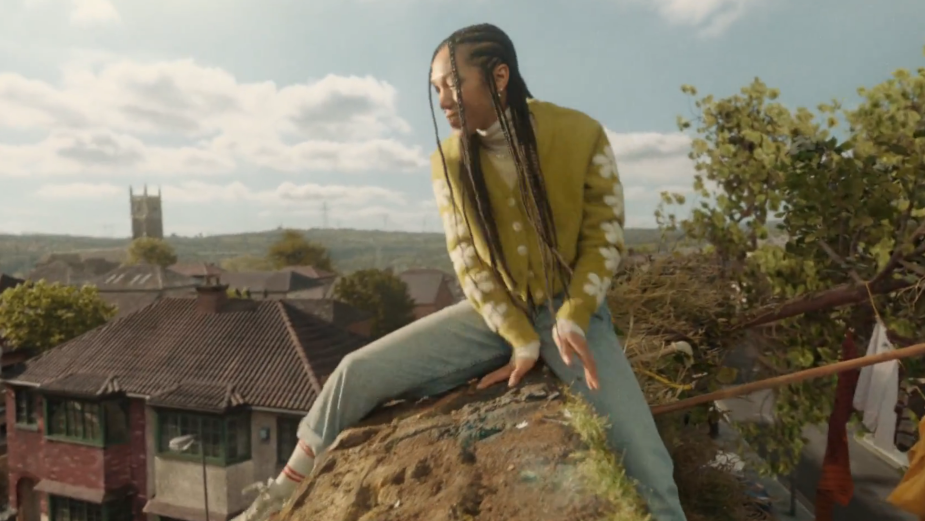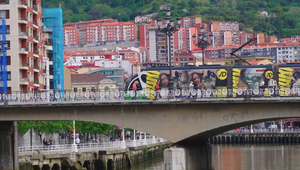
How B&Q Embraced Change by Flipping a Six-Story Set Upside Down

Change: something on everybody’s mind, especially when springtime arrives. Be it a refreshment of your wardrobe, or a full-on flip around of your house, change is something we all crave at certain times of our lives and albeit scary, it is an essential component of doing everything in your power to avoid stagnation. Mix it in with some retail therapy, and you get home renovation! It could refer to moving homes, or just adding those essential little sparks of inspiration in your bedroom to make it just like the Pinterest board you’ve been updating frantically in the middle of the night. UK’s leading home improvement and garden retailer B&Q knows this about us all - we need change, and we need it fast and easy. Home renovation can be extremely stressful, especially if you’re not the best at making decisions, so B&Q’s latest brand campaign promises exactly this - any change its customers might desire will go swimmingly, at the speed that works best for them.
Under the name ‘Change. Made Easter.’ the campaign is a collab between the brand, Pulse Films and Uncommon Studios and features the epic 90-second film titled ‘Flip.’ B&Q knows that flipping your life around with that sort of ease can be done only through DIY.com, which is a network of over 300 stores giving customers access to Click & Collect on over 20,000 items and home delivery service on even more, helping with designing bathrooms, kitchens and any bulk purchases. To convey this, the film sets the scene: a mum of one sits in the family’s spare box room, holding in her hands what will be the first push for the major change, a positive pregnancy test. Exhaling a deep breath, she quickly hides the positive test from her partner entering the room.
This is when things start to get wild. Under the opening piano interlude, from David Bowie’s ‘Sound and Vision,’ the main character takes charge of her surroundings in a never-before-seen manner. Why David Bowie? Dan Neale, music supervisor from native explains: “This was a really interesting film to try tracks against as it is so strong that many things worked, just in very different ways. I think in the end what worked for everyone with this version of ‘Sound and Vision’ is that it is very simple, but very powerful. It echoes the film because what is happening on screen has real scale, but also allows the intimacy of the moment to come through.”
With change at the forefront of her mind, the mum then starts renovating through a few easy clicks on her phone, as we, the audience, watch her home turn upside down before our eyes. As books fall from the shelves, the kitchen table slides, the floor tilts and shadows from the outside extend into the house, the entire house starts taking a new shape. Even the garden outside flips at 180 degrees, as the protagonist climbs effortlessly on top of it to peek through and see a new, renovated home that she bravely slides into. After entering her new and improved home, the mum breaks the news, as audiences look through the window of the house and see other homes on the street literally and figuratively flip in the same manner. Overall, the craft and imagination that has gone into the film is too epic to describe.
Oscar Hudson at Pulse Films, who directed ‘Flip’ can definitely confirm that there was a lot of work that went into it. “We wanted to use long unbroken takes and in camera effects,” he says. “This meant the set design, the camera move, the performance and the edit all basically became one intertwined entity so you have to be very deliberate about absolutely everything from an early stage.” The step one of production, which was building a physical spinning model of the set, was essential when it came to figuring out everything else in the film. Oscar explains that there was a lot to juggle on set – the best motion for the camera in conjunction with the actor’s climbing route, the placement of the stunt wires, the speed of the spin of the ginormous set, so it could fit the 90 seconds.
The hardest, and probably most mesmerising bit, was the fact that essentially the set was a huge double-sided house and garden that literally flipped over. “All the actor’s movement was achieved practically on a real moving set, the actress was on a wire which of course had to be painted out, but this wire was only there for her safety rather than to assist her movement or pull her up the wall,” explains the director. “All the tilting movement and the falling objects were done practically too. Certain elements in the interior of the ‘old house' were on bomb-releases so we could better control the timing of their motion but there’s no additional CG elements in there aside from a touch of clean up here or there.” Oscar explains the outside world once the actor leaves the house is where Electric Theatre Collective and their CGI work really comes in.

When it comes to the experience of working with a flipping set, Oscar says that to defy gravity was a genuinely absurd experience. “I actually learned a lot about applied physics! It’s like trying to shoot underwater or on the moon.” To him the most complex bit was figuring out the camera grip that makes perfect sense, but then having to change the shot suddenly as five seconds later the ‘ground under your feet has become a wall.’ Not to mention that the camera operator is hanging off a wire, climbing a moving wall with no hands, six stories in the air! The set was built six metres off the ground and reached 21 metres at the top, so safety was paramount and always the number-one priority, which led to constantly having to adapt camera moves and removing parts of it to keep safety lines free.
When it comes to in-camera work, Oscar reveals that there are about three hidden in-camera cut points. “I’m sure film savvy people can figure out exactly where – just basic whip pans really, but of course this approach within the context of a fixed-length advert means you need to absolutely nail your in and out point timings.” For him, the storyline was quite clear cut – in order to echo what B&Q wanted to portray, a young family was the perfect fit, and the pregnancy bit was added later on to provide for the narrative progression and emotion, which doesn’t run low in a film that literally turns somebody’s life upside down.

Looking at the world created outside of the house is when things get even more complicated. From the initial meetings with Oscar, ETC knew that the role of CG and post in the project was to compliment what was captured in camera, but not overpower the narrative. Having that said, they still had to create an entire world outside of the house and make it feel natural and convincing enough, “so that the viewer wouldn’t question it.” Using a mix of existing locations and 3D models, they created a virtual town which extended from the hero house “into the final matte painting landscape.” The project was worked on by senior producer Holly treacy, CG lead Patrick Krafft, 2D Lead Alex Snookes and was graded by Luke Morrison.
“The internal logic meant the world had to remain in the same position as the hero travelled, but the set would rotate 180 degrees with the houses mirrored along the plane of the ground,” the CG crew explains. “We found we had to flip the world 180 degrees on the way down in order to keep the view consistent; this affected everything, even the light direction.”
Colourist Luke Morrison explains that in this context, the grade had to help subtly emphasise the change of states between the spaces.“In the opening we used some windowing and shaping to bring the space in more, and sucked out some of the colour in the walls whilst still retaining pops of colour in the props,” he says. “In transitioning to our end house, the goal was to create a more open, clean feeling with more warmth to it. We played with really pushing the two houses aesthetically in very different directions with the grade, but with almost a continuous shot in the climb section, it wasn't possible as it became too distracting to transition between these more extreme looks. It was also important that the cast felt consistent throughout, in terms of skin tone and wardrobe.”
Because the crew knew that the naturalistic look was what was necessary in the project, they explained that on-set blue screens quickly became problematic, also because of the scale of the set itself. “It meant we would have needed an enormous amount of blue to cover it all. We also discovered that if we surrounded the set with blue, it would have meant that we couldn’t light it. We then decided to cover off the areas we could, then backlighting our hero which meant her edge detail would be preserved.”
Also because of the sheer size of the set, a shot could take up to eight hours to shoot and was made even trickier with the limitations on how many people could be on it at once. “To help move things along in the build up to the main set being created, we had replica sets built on the ground level. This gave us better access to work out camera moves and timings of movement through the set. Wherever possible we shot on these sets as it was a lot simpler to work on them and not be held back by weight restrictions, or having to elevate everything to the set height. As they had only enough props to dress the main set, it meant we had to replace backgrounds with plates from our hero sets in post,” explains senior producer Holly Treacy.
Once the crew entered post production, they wanted to add on as many real elements and components as possible. So, in addition to the CG set dressing assets, they used a drone and other cameras to shoot people, buildings and even animals to add into the final shots. “A lot of work was done to each shot to add realism and “ordinariness”, making the location appear more authentic.

One of the heaviest areas of post was the end shot. On set we initially shot our models and layout, but quickly discovered that in order to make this shot readable we needed to flip more houses than we had originally thought. This meant rebuilding much more of the landscape in CG and retexturing a lot of our scanned models so they would hold up in the final frame. We then combined matte painting for the mid and background, and added numerous plates of people, cars, animals and imperfections to give the image more life.
In the end there are only a few elements that remained from the original plate and model. But we will let you try to figure out which parts they are!”

The film ‘Flip’ comes as part of the already established character that the B&Q brand has amongst British audiences. With their 2020 campaign ‘Build a Life’ the retailer set the bar high for emotive advertising in their playing field and managed to establish a connection with viewers that helped all of them celebrate the potential of change. In this year’s campaign this is exactly what they are doing. They are showing us a story of love, family, and change, being embraced like we have never seen before - by flipping a 24-ton, six metre high set on its head.















